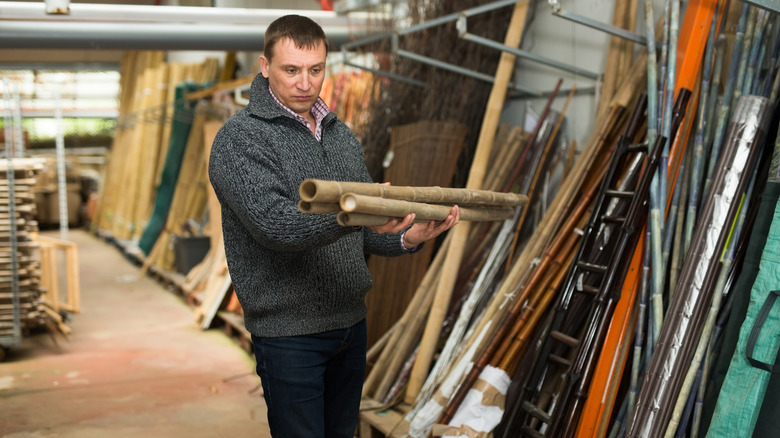The Stunning Natural Clothes Rack You Can DIY To Free Up Closet Storage Space
Few of us have mastered a Marie Kondo-esque level of closest organization. That means you're likely battling with clothes strewn across chairs or your bed, falling out of drawers, or simply lying haphazardly on that once-fluffy rug. You need an easy-to-make, aesthetically pleasing clothes rack you can shove into the corner of your bedroom, ready and waiting to host all your winter coats and clean-but-not-yet-put-away workout clothes that usually (un)grace the floor. At its simplest, this clothes rack requires six poles of unfinished bamboo, some bolts and zip ties, and a few everyday tools.
Hanging your clothes is arguably one of the best ways to organize all different kinds of clothing. Pretty much every item you own can be hung on a rack; it's an especially useful closet, walk-in wardrobe, or bedroom storage tool for those who hate ironing or want wrinkle-free attire in easy reach. That's because hanging your clothes allows gravity to do all the work, pulling those crumple zones straight and keeping vertical pleats crisp. (An exception: Knitwear and items made from stretchy or heavy fabrics should always be folded in a drawer.) Plus, bamboo is relatively affordable, easy to work with, and surprisingly strong for a natural material while staying light on its roots. In fact, its tensile strength outpaces that of hardwoods like oak and maple.
Source your bamboo poles
Honestly, pretty much any bamboo will work for this trick, so long as the poles are straight, long enough, and somewhere between 1 and 3 inches in diameter. The length of your rods is flexible; it depends on how large a rack you want to make. At a minimum, for a moderately sized frame, you'll need four 68-inch long poles to create your two A-frame legs. Two 36.5-inch long poles connect the A-frames horizontally across the base, and another two 18.5-inch long rods brace each A-frame. Another 36.5-inch long bar runs horizontally across the top of the rack — this is what you'll hang your clothes on.
If you already grow and take care of bamboo plants, you'll have a stand of ready-made poles from which to harvest. This is by far and away the most affordable option. Use a machete to cut the branches at their base and, using the same blade, shave any sticky-out bits from the poles, making them as straight and smooth as possible. Otherwise, you can buy them — though not always cheaply, honestly — from online retailers or big box hardware stores alike. Walmart sells a 25-pack of Backyard X-Scapes 1-inch diameter, 72-inch long natural bamboo poles for $51.49. If you want a long-lasting product, shop with a bamboo specialist. Forever Bamboo has a set of 15 1-inch diameter, 90-inch long hollow bamboo poles for $219.95.
Wrangle the wood into a rack
You'll also need a measuring tape and saw to cut the bamboo into the correct lengths. If you have a well-equipped workshop, use your circular saw to cut the poles. Otherwise, a manual saw works just as well. We recommend a Japanese bamboo cutting saw like the one from My Boo Workshop for $24.95. To connect everything, grab a power drill, steel bolts about double the diameter of your poles, matching wing nuts, and a handful of zip ties.
Lay two of your four 68-inch long poles on the ground and cross them at the top, around 6 inches down the pole. Do the same for the other set of bars. These will become your A-frame legs. Place the two 18.5-inch long braces between each set of poles, again, around 6 inches from the bottom of the rods. Mark where your bolts will go with a carpenter's pencil and drill perfectly straight holes right through each pole. Where the A-frame crosses at the top, you'll need to drill holes horizontally through both poles. The holes for the braces go through both poles at a 45-degree angle to the leg poles. Thread the bolts through, secure the wing nuts, and, if you wish, brace each joint with a zip tie. Repeat this process for the long horizontal braces. The top pole — the bar you hang your clothes on — sits loosely across the top of the rack, supported in the cross of the leg poles.

